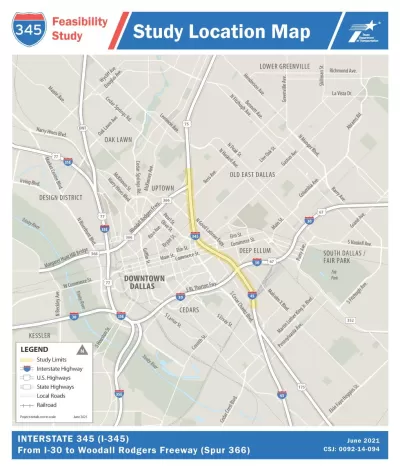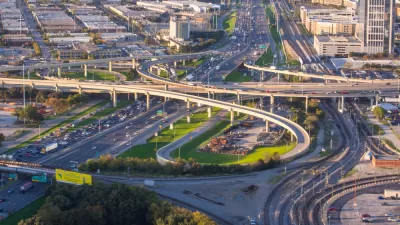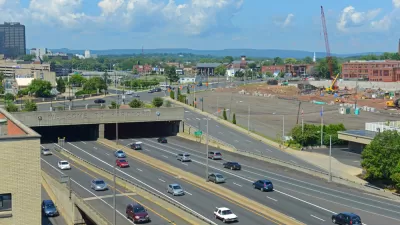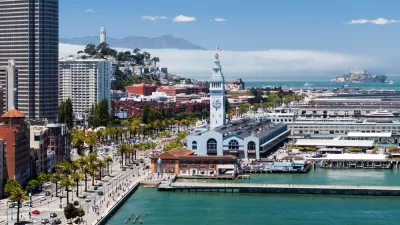Freeways have been removed before, but if the Texas Department of Transportation decides to tear down the I-345 freeway in Dallas, it would reflect a massive sea change in urban transportation planning.

"If you will excuse the pun, it looks like we may finally be approaching the end of the road — or at least the beginning of the end of the road — in deciding on a future for Interstate 345," writes Mark Lamster.
The Texas Department of Transportation (TxDOT) is wrapping up public comment on a feasibility study for the future of I-345 that includes an option to tear down the elevated freeway, reconnecting Downtown Dallas to the neighborhood of Deep Ellum.
As explained by Lamster, the feasibility study offers five possible alternatives: "repairing the road but leaving it unchanged; keeping it as an elevated highway but with a slimmer profile; depressing it into a trench (like U.S. 75) that can be bridged and decked; removing it altogether; and a hybrid combination of the trench and removal options."
According to Lamster, there was enough reaction to the feasibility study that TxDOT extended the deadline for public comment. We already know what advocates want—I-345 in Dallas made the 2019 "Freeways Without Futures" report published by the Congress for the New urbanism.
Discussions about what to do with the rapidly approaching obsolesce of the freeway's elevated structure has been ongoing since 2013, according to Lamster, and the tear-down alternative has emerged as a well considered planning alternative along the way:
The tear-out proposal, developed by the urban planner Patrick Kennedy, was a chance to re-knit the city while freeing up a huge swath of land for the kind of mixed-use, affordable development it desperately needed. Careful analysis of traffic patterns suggested that a new street system with boulevards and increased connectivity would avert serious congestion and massive delays, adding a mere five minutes to commutes.
Lamster voices his support for removal: "Of TxDOT’s five options, removal is the most logical, best option. Retaining the status quo at enormous cost would seem to be the worst possible choice."
FULL STORY: Dallas has 5 options for the future of I-345. Only one makes sense

Planetizen Federal Action Tracker
A weekly monitor of how Trump’s orders and actions are impacting planners and planning in America.

Canada vs. Kamala: Whose Liberal Housing Platform Comes Out on Top?
As Canada votes for a new Prime Minister, what can America learn from the leading liberal candidate of its neighbor to the north?

The Five Most-Changed American Cities
A ranking of population change, home values, and jobs highlights the nation’s most dynamic and most stagnant regions.

‘Quality Work, Fast’: NC Gears up for Homebuilding After Helene, Trying to Avoid Past Pitfalls
The state will field bids to demolish, repair and rebuild homes in the mountains. After struggles in eastern NC, officials aim to chart a different course.

Washington State’s Parking Reform Law Could Unlock ‘Countless’ Acres for New Housing
A law that limits how much parking cities can require for residential amd commercial developments could lead to a construction boom.

Wildlife Rebounds After the Eaton Fire
Following the devastation of the Eaton Fire, the return of wildlife and the regrowth of native plants are offering powerful signs of resilience and renewal.
Urban Design for Planners 1: Software Tools
This six-course series explores essential urban design concepts using open source software and equips planners with the tools they need to participate fully in the urban design process.
Planning for Universal Design
Learn the tools for implementing Universal Design in planning regulations.
Central Transportation Planning Staff/Boston Region MPO
Heyer Gruel & Associates PA
Institute for Housing and Urban Development Studies (IHS)
City of Grandview
Harvard GSD Executive Education
Regional Transportation Commission of Southern Nevada
Toledo-Lucas County Plan Commissions





























